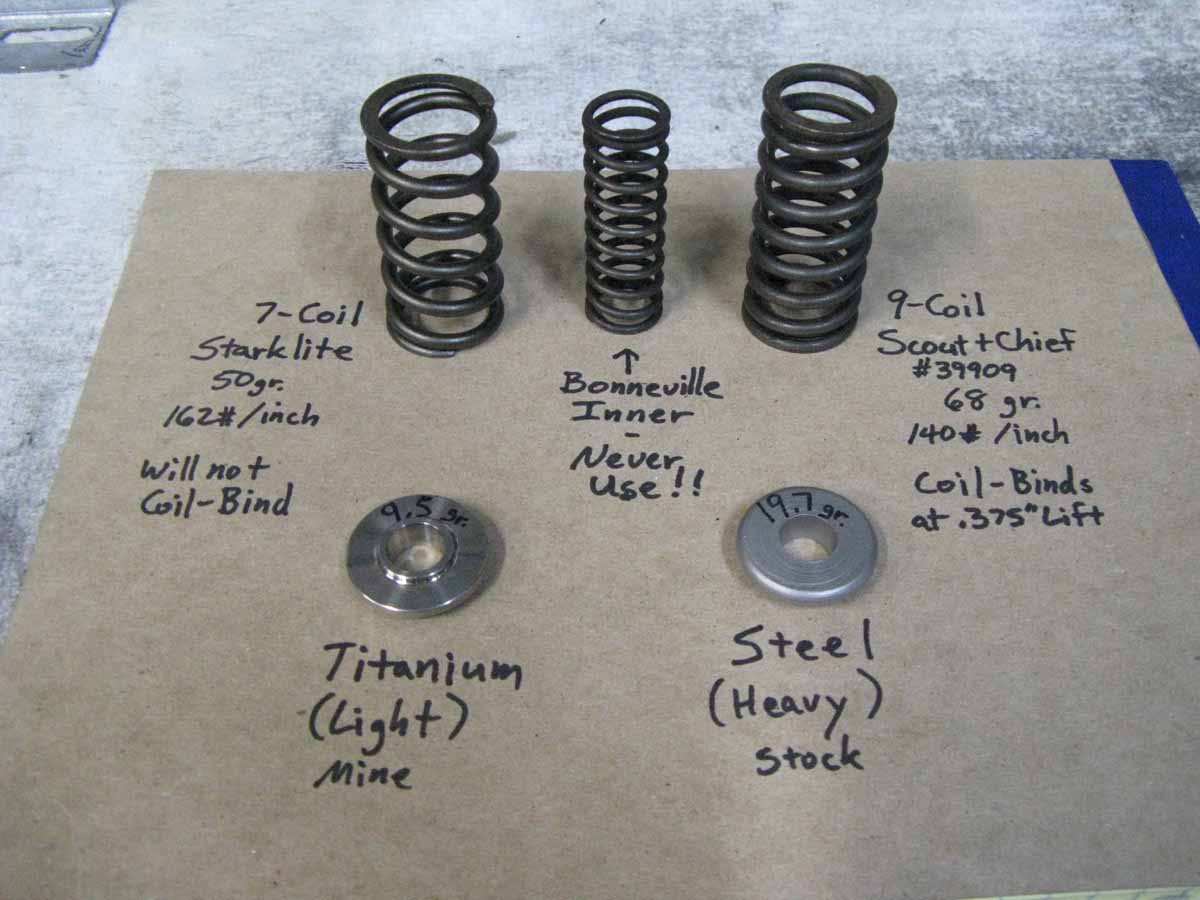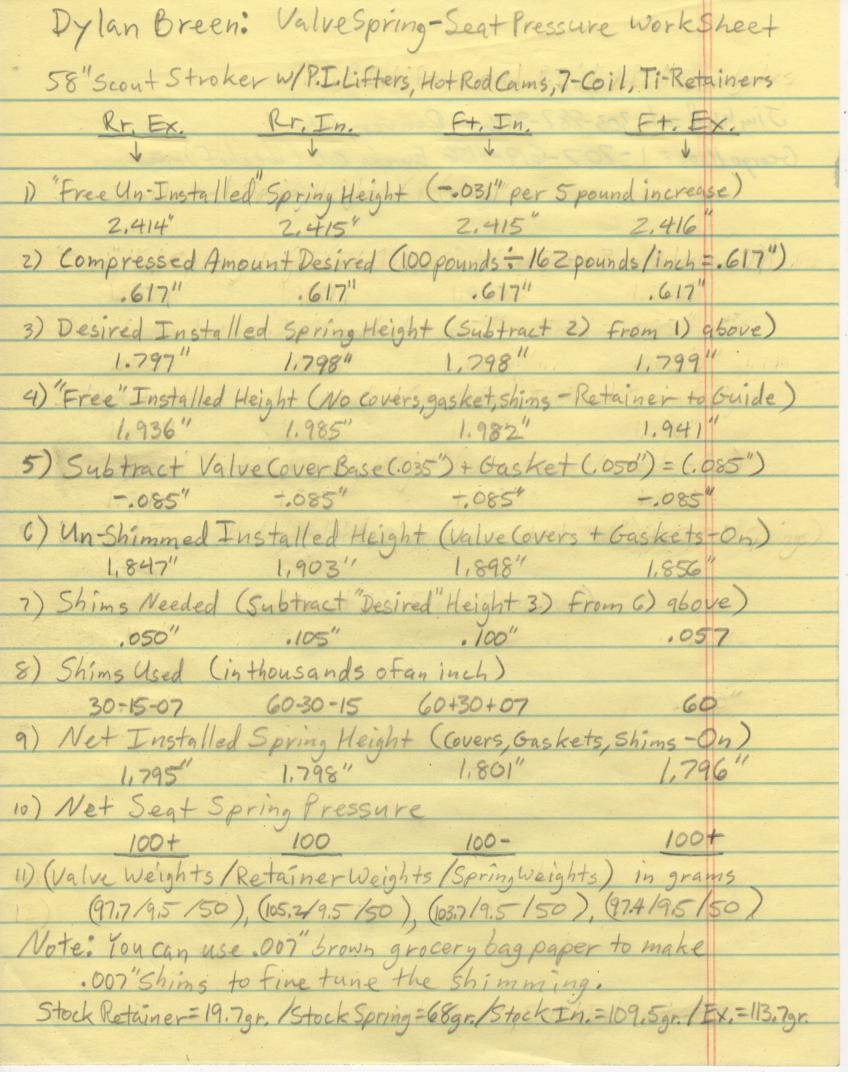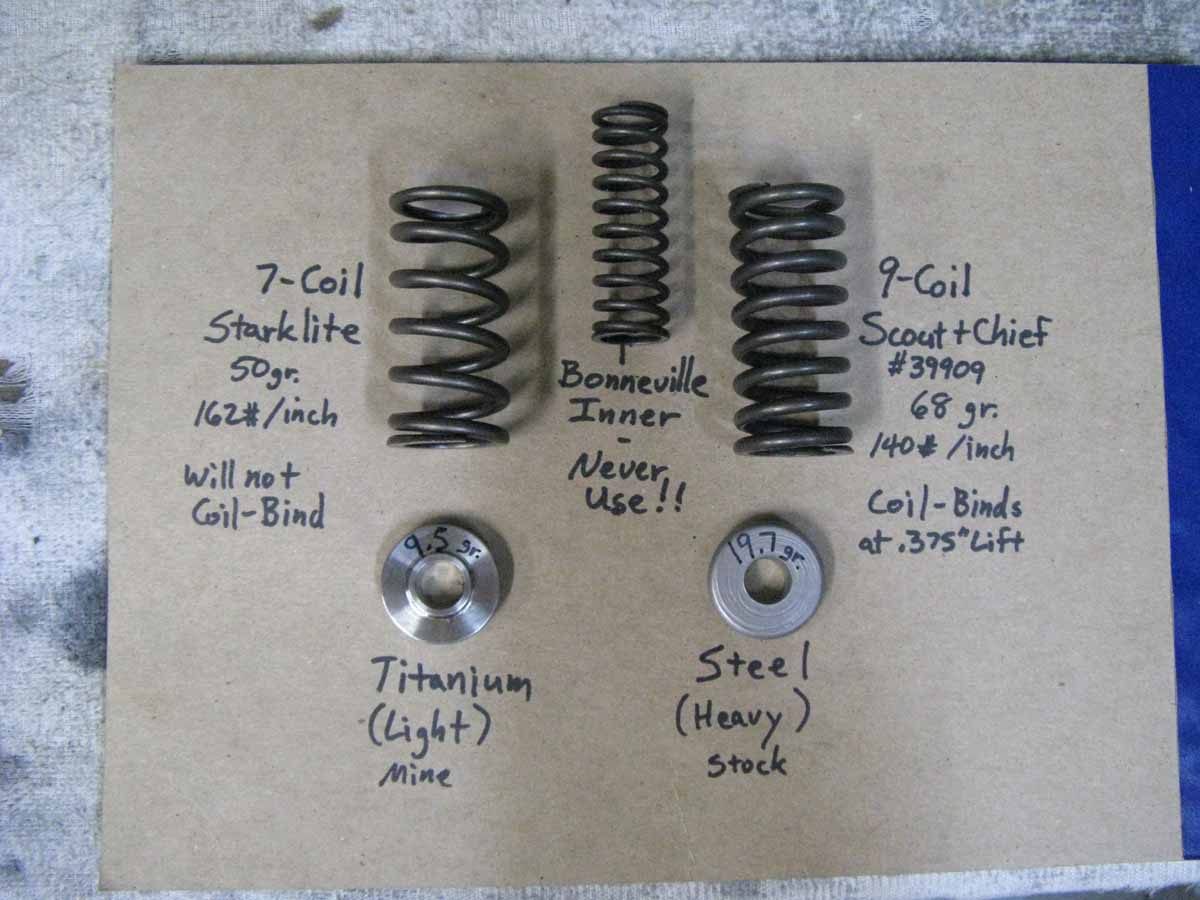An Indian Valve Spring Study
This Valve Spring Study is for pre-war, and post-war Chief & Sport Scout applications. Chief and Sport Scout springs (part #39909) are the same spring with 9 full coils, while the 741 model springs (part #39908) are shorter with 8 full coils. Bonneville Chief Inner springs can be used with either spring for a pressure increase of 25% at all lift points. We will not be discussing the use of springs for the 741 models here.

See below for pictures, Valve Spring data, and Spring Pressures.
Parts Used:
1) Indian Chief, or Sport Scout cylinders with new valve guides, honed to fit, with valve seats cut, and lapped to the valves.
2) New, or re-conditioned Valves, that can be slightly lightened for higher reving. Plus, re-profiled for better flow.
3) Starklite Cycle 7-coil valve springs. Never use standard #39909 9-coil springs, or Bonneville inner springs.
4) (4) Original valve spring retainers, and (8) original keepers. Or, preferably, my Titanium light weight retainers.
5) New Starklite Cycle "Highest Quality" valve guides, with Perfect Circle brand Teflon seals on the Intakes only.
6) New Starklite Cycle "O-Ring" valve covers (Chief base thickness = .075"), (Sport Scout base thickness = .035").
7) Fiber "O-Ring" seals under the valve covers at .060" thick (.050" thick also available).
Objective:
To test for available valve lift, before valve spring "Coil-Bind" occurs, as well as calculating the optimum spring seat pressures to prevent valve foat at high RPM. Coil-bind is when the valve spring is fully compressed. There is limited valve travel available when using standard Chief components, and by varrying the optional components, increased valve lift heights, and valve spring pressure rates may be achieved. I am setting-up a Chief "Hot Rod" motor using Very Hi-Lift cams (.486" lift!), and I need to provide for safe clearance between every spring coil at maximum valve lift. The minimum recommended clearance between coils (at proper spring pressure rates) is .010" per coil for high-reving automotive springs (I consider this to be too tight!). Standard Chief & Sport Scout cams only offer .330" of valve lift, so coil-bind is never a problem. Bonneville cams, on the other hand, offer around .410" valve lift, and coil-bind becomes an issue (especially when using the .060" fiber gasket under the valve cover). On my sample parts listed above, I found that the Chief (9 coil) spring will coil-bind at .375" of valve lift when using the "O-Ring" valve covers, and using the .060 gasket under the valve covers. With the .060" gasket installed, the springs will coil-bind in most cases causing damage to the cam lobes, push rods, lifters, and rollers! My data shows that by selecting the correct optional components (Starklite Cycles 7-coil spring), that ample coil-bind clearance can be found even when using extreme hi-lift cams. Also, valve train weights must be reduced, and spring seat pressures increased if high RPM is desired for racers, or Hot Rodders!
Observations:
Valve stems are cut with grooves at their end to hold a "keeper and retainer" combo in place while compressing the valve spring under them.
There are commonly known valve spring pressure rates based on the total mass of the valves, springs, and other valve train components, while considering the RPM range desired.
Chief valve train mass moving at a lower maximum RPM range can get away with slightly lower spring pressure rates. Sport Scouts, with a much shorter stroke will rev higher, and although the valves are a bit lighter, they will require more spring seat pressure to handle the higher RPM range at full throttle to prevent valve foat.
The recommended spring pressure rates (given to me by a spring vendor), based on the total mass of an average Chief is: around 130 pounds with the valve closed, and around 350 pounds when approaching lifts of .500". We can not meet these pressures with Sport Scout, or Chief springs, but we can get away with a little less pressure due to our lower RPM range. We never need to worry about piston, or valve damage by hitting each other when the valves "float", because Indians are "Flat Heads"! Valve float should be avoided, because it can still cause damage to the cams, and lifters. I have found that in racing my Twin-Scout that Chiefs and Scouts need 105 pounds of seat pressure to avoid valve float (except for real high RPM use), and by using the 7-coil springs, it should make around 175 pounds of seat pressure. These seem low for racing, but it is a good idea to not go too high with seat pressures, so we can extend the life of our cam bushings, shafts, and lifters.
Consistant spring pressures can be reached from one valve to the next by trying to keep the installed spring heights the same. This can be done by swapping the retainers around, by shimming, or by using "offset keepers".
I found that between the (4) original retainers I have, that I found (4) different installed spring heights when sampled on the same valve position. One retainer offered 1.900" installed spring height between the bottom of the retainer to the guide's spring surface, while another offerred 1.855" (a .045" difference!). All (4) retainers gave me a different measurement. I recorded how much each retainer raised this installed height higher than the shortest one. I took the shortest retainer, and then measured all (4) valve positions to find the installed height per valve location. I swapped the retainers around to come up with a combination where all (4) valves had similar installed spring heights. By doing this, all (4) valve springs have nearly equal spring pressures, and coil-bind clearance. Then, they will get about the same amount of shimming to get the desired 105 pounds of seat pressure.
On my Hot Rod motor, my rear intake seat had been cut a little more than the others, and by swapping retainers around, I was able to compensate for this.
Starklite Cycle Springs have (7) full coils, where Chief springs have (9). They both use the same wire size, and diameter, but the Starklite spring is a little shorter (compressed and free length). The Starklite 7-coil spring is actually stiffer at maximum lift, because the shorter (7) coil spring is made from a shorter piece of wire, and has to torsionally rotate 22% more for a given amount of travel than does the Chief spring.
The Starklite Spring is a "linear" spring, where it's spring rate is constant while being compressed. It measures 162 pounds at 1" of compression, and half that (81 pounds) at 1/2" of compression. The standard Sport Scout, and Chief Spring is at 140 pounds per inch of compression. There are progressive, and "Bee-Hive" springs out there, but it is not necessary to consider them, and they are harder to calculate seat pressures with.
Bonneville Inner Springs will not coil-bind, and when added to Chief springs, the spring pressures will increase 25% across the entire range. They also add more spring mass to the equation, which promotes valve float. They should NEVER be used! The Indian factory really missed this one! Especially considering that the Bonneville Chief cams offered more valve lift than the springs can support. Consequently, most all Bonneville Chief's valve train components were wearing out quickly as soon as they were brought into service.
The compressed (coil-bind) height of the Starklite Cycle spring is 1.001", and for Chief springs it is 1.357". That's .356" more lift available before coil bind!
The base thickness of the Starklite Cycle "O-Ring" Valve Covers is .075" thick (most Sport Scout covers=.035"). Plus the valve cover base gaskets can be either .050", or .060" thick depending on the vendor. This is used to help calculate for coil-bind clearance, and spring pressures.
Problems and Solutions
Valve float is very destructive! It is caused from the RPM raising to a point, where the spring pressure can not keep the lifter's roller pinned down to the cam lobe, especially at the max lift point of the cam lobe. When the valve floats, it breaks contact, and then comes down "hammering" the roller to the cam lobe. This can cause lifters, or rollers to break, and the results are catastrophic! Usually everything gets ruined in the cam chest. Pay attention to valve float!
Worn, or used cylinders will have valve seats that have already been cut, which will influence how much valve stem is sticking outside of the valve guide. This holds true for new cylinders, or cylinders with new seats installed. Therefore, you can not predict how much installed spring height that exists, without measurements being taken.
To get the proper installed spring heights, you can add shims to reduce the installed height. Shims are easily available, where ever valve train parts are sold. I use a common shim in thicknesses of .015", .030", and .060" thicknesses. I usually have to open up the inner hole with a Dremel sanding barrel, to fit the valve guide base UNDER the valve covers.
To make this easier, I have already measured the spring rates at different compressed heights using the 7-coil Starklite Cycle springs. They offer 162 pounds of pressure for each 1" of compression, and they are linear.
I have measured on a spring tester the following installed spring heights for Starklite Cycles 7-coil springs. I found for 100 pounds=1.790", for 105 pounds=1.759", and for 110 pounds=1.728". These are close numbers considering the inherant errors found with most spring compression guages. The best way to calculate spring pressures is by using my Spring Pressure Work Sheet and Sample Spring Pressure Work Sheet.
Valve seat spring pressures are somewhat subjective. It is all based on the total valve train weights (or mass in motion), at the desired max RPM. As an example, I use Titanium valves, retainers, and keepers in my Twin-Scout Bonneville racer (2-58" Stroker Scouts), and I found some evidence of valve float at 5,700 RPM when using 95 pounds of seat pressure. I increased it to 105 pounds, and the valve float went away. My smaller 45" race motors use 110 pounds seat pressure, and safely revs to 7,500 RPM. My Titanium parts weigh only 60% of the standard steel components. A valve train setup with all steel components will need to have more spring seat pressure than Titanium, and a 45" Scout racer might need to be near 110 pounds (1.670" installed height), due to the higher RPM range.
If you intend to rev your motors at sustained high RPM, then you need to pay attention to total valve train weights. I usually find a way to reduce some of the valve weight, by either reducing the thickness of the valve head, or adding a small "hollow" ground into the valve's face, or re-profiling the tulip area of a valve head closer to the seat face, which also helps flow some. For those who want to spend more money, you can have custom valves made with smaller (lighter) valve stems, and then make custom valve guides.
I also make, sell, and use Titanium valve spring retainers, which will drop the weight by 10.2 grams each (less than 1/2 the weight!). The lighter the valve train mass, the higher the revs! By using my Titanium retainers, and the 7-coil springs, you will reduce the moving mass of each valve by over one full ounce!
How to calculate Valve Spring Installed Heights
First, use fully prepared cylinders, where the valve seats have been cut, and the valves have been ground (or new). It is important to commit valves, springs, and retainers to each valve location, and don't mix them up during this installation (mark the parts). Install each valve in it's valve guide, and loosly install the retainer with the (2) keepers. You can pull up hard on the retainer, and it will stick in place without falling apart. Then, with a good set of calipers and "T" guage, take a measurement from the underside of the retainer, where the spring sits down to the flat on the valve guide, also where the spring sits. Record these measurements for each valve.
As mentioned above, retainers are not all made the same, and by shuffeling the retainers around, you might find that you can get these measurements to be closer to each other.
Then, decide the Valve SpringSeat Pressure desired based on weights, RPM's, stroke, etc. Use the info above (100 pounds=1.790" for the Starklite 7-coil springs), etc.and write that down. You will be adding a valve cover, and a valve cover base gasket, and these need to be measured (Scout covers are .035" thick, and Starklite gaskets are .050"). When installed, they will further compress the spring. The installed height of a spring is then the distance from the underside of the retainer down to the inside surface of the valve cover.
So, measure the free installed height, subtract the thickness of the valve cover, and gasket to get a number. If it is more than the desired installed height for your desired seat pressure, you will have to shim under the valve cover to further compress the valve spring. Look below for a sample work sheet for calculating valve spring seat pressures.

On the left is the Starklite Cycle 7-coil Spring. It will never coil-bind. In the middle is the Bonneville Inner Spring, and on the right is the standard Chief or Sport Scout #39909 Spring. By using my Titanium retainers, and the 7-coil spring, you will reduce the moving mass of each valve by a full ounce!

CONTACT INFORMATION:
James R. Mosher
1-505-466-7870




